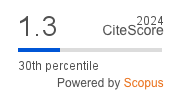A dilution method to increase the yield of engineered basic fibroblast growth factor
Downloads
Background: Genetically engineered chimeric proteins have potential applications as components of dental materials and can be synthesized recombinantly in various cells, including bacteria, yeast, insects and mammals. However, increasing the yields of functionally active products remains a challenge. Purpose: This study focused on basic fibroblast growth factor fused with pentadeca (GGGGS)3 peptide as a linker and hexahistidine as an affinity tag (bFGF-PH). The objective was to enhance the yield of bFGF-PH expressed in bacteria by employing a dilution method. Methods: Escherichia coli was used to express bFGF-PH in a soluble form, which was then purified using metal chelate affinity chromatography. The protein solution was diluted 100-fold with a buffer solution to promote spontaneous refolding. Subsequently, the protein solution was concentrated using metal chelate affinity chromatography. Circular dichroism (CD) spectroscopy was used to analyze the protein’s structure, assessing its correct folding by comparing it to a reference spectrum obtained through computer-based simulation. Results: The dilution method prevented bFGF-PH aggregation, and CD spectroscopy suggested that the protein was correctly folded. As a result, a total of 3.0 mg of bFGF-PH was obtained per liter of lysogeny broth medium, which was higher than the yield achieved using the conventional method. Conclusion: The dilution method examined in this study increased the yield of correctly folded bFGF-PH.
Downloads
Zhu W, Kong C, Pan F, Ouyang M, Sun K, Lu S. Engineered collagen-binding bone morphogenetic protein-2 incorporated with platelet-rich plasma accelerates lumbar fusion in aged rats with osteopenia. Exp Biol Med. 2021; 246(14): 1577–85. doi: https://doi.org/10.1177/15353702211001039
Nakamura S, Ito T, Okamoto K, Mima T, Uchida K, Siddiqui YD, Ito M, Tai M, Okubo K, Yamashiro K, Omori K, Yamamoto T, Matsushita O, Takashiba S. Acceleration of bone regeneration of horizontal bone defect in rats using collagen‐binding basic fibroblast growth factor combined with collagen scaffolds. J Periodontol. 2019; 90(9): 1043–52. doi: https://doi.org/10.1002/JPER.18-0674
Jeon E, Yun Y-R, Kim H-W, Jang J-H. Engineering and application of collagen-binding fibroblast growth factor 2 for sustained release. J Biomed Mater Res Part A. 2014; 102(1): 1–7. doi: https://doi.org/10.1002/jbm.a.34689
Paulini M, Camal Ruggieri IN, Ramallo M, Alonso M, Rodriguez-Cabello JC, Esbrit P, Mardegan Issa JP, Feldman S. Recombinant proteins-based strategies in bone tissue engineering. Biomolecules. 2021; 12(1): 3. doi: https://doi.org/10.3390/biom12010003
Abe F, Nakano A, Hirata I, Tanimoto K, Kato K. Structure and function of engineered stromal cell-derived factor-1α. Dent Mater J. 2024; 43(2): 2023–247. doi: https://doi.org/10.4012/dmj.2023-247
Shakya A, Imado E, Nguyen PK, Matsuyama T, Horimoto K, Hirata I, Kato K. Oriented immobilization of basic fibroblast growth factor: Bioengineered surface design for the expansion of human mesenchymal stromal cells. Sci Rep. 2020; 10(1): 8762. doi: https://doi.org/10.1038/s41598-020-65572-2
Nakano A, Kato K. Regenerative nanotechnology: Engineered surfaces for stem cell production. In: Gu N, editor. Nanomedicine Micro/Nano Technologies. Springer; 2023. p. 605–22. doi: https://doi.org/10.1007/978-981-16-8984-0_20
Beygmoradi A, Homaei A, Hemmati R, Fernandes P. Recombinant protein expression: Challenges in production and folding related matters. Int J Biol Macromol. 2023; 233: 123407. doi: https://doi.org/10.1016/j.ijbiomac.2023.123407
Yamaguchi H, Miyazaki M. Refolding techniques for recovering biologically active recombinant proteins from inclusion bodies. Biomolecules. 2014; 4(1): 235–51. doi: https://doi.org/10.3390/biom4010235
Wang W, Roberts CJ. Protein aggregation – Mechanisms, detection, and control. Int J Pharm. 2018; 550(1–2): 251–68. doi: https://doi.org/10.1016/j.ijpharm.2018.08.043
Shendge AA, D’Souza JS. Strategic optimization of conditions for the solubilization of GST-tagged amphipathic helix-containing ciliary proteins overexpressed as inclusion bodies in E. coli. Microb Cell Fact. 2022; 21(1): 258. doi: https://doi.org/10.1186/s12934-022-01979-y
Schäfer F, Seip N, Maertens B, Block H, Kubicek J. Purification of GST-Tagged proteins. Methods Enzymol. 2015; 559: 127–39. doi: https://doi.org/10.1016/bs.mie.2014.11.005
Moghadam M, Ganji A, Varasteh A, Falak R, Sankian M. Refolding process of cysteine-rich proteins: Chitinase as a model. Reports Biochem Mol Biol. 2015; 4(1): 19–24. pubmed: https://pubmed.ncbi.nlm.nih.gov/26989746/
Li X, Jin J, Guo Z, Liu L. Evolution of plasmid-construction. Int J Biol Macromol. 2022; 209(Pt A): 1319–26. doi: https://doi.org/10.1016/j.ijbiomac.2022.04.094
Konagaya S, Kato K, Nakaji-Hirabayashi T, Arima Y, Iwata H. Array-based functional screening of growth factors toward optimizing neural stem cell microenvironments. Biomaterials. 2011; 32(22): 5015–22. doi: https://doi.org/10.1016/j.biomaterials.2011.03.066
Drew ED, Janes RW. PDBMD2CD: providing predicted protein circular dichroism spectra from multiple molecular dynamics-generated protein structures. Nucleic Acids Res. 2020; 48(W1): W17–24. doi: https://doi.org/10.1093/nar/gkaa296
Jacinto‐Méndez D, Granados‐Ramírez CG, Carbajal‐Tinoco MD. KCD: A prediction web server of knowledge‐based circular dichroism. Protein Sci. 2024; 33(4): e4967. doi: https://doi.org/10.1002/pro.4967
Tunyasuvunakool K, Adler J, Wu Z, Green T, Zielinski M, Žídek A, Bridgland A, Cowie A, Meyer C, Laydon A, Velankar S, Kleywegt GJ, Bateman A, Evans R, Pritzel A, Figurnov M, Ronneberger O, Bates R, Kohl SAA, Potapenko A, Ballard AJ, Romera-Paredes B, Nikolov S, Jain R, Clancy E, Reiman D, Petersen S, Senior AW, Kavukcuoglu K, Birney E, Kohli P, Jumper J, Hassabis D. Highly accurate protein structure prediction for the human proteome. Nature. 2021; 596(7873): 590–6. doi: https://doi.org/10.1038/s41586-021-03828-1
Evans R, O’Neill M, Pritzel A, Antropova N, Senior A, Green T, Žídek A, Bates R, Blackwell S, Yim J, Ronneberger O, Bodenstein S, Zielinski M, Bridgland A, Potapenko A, Cowie A, Tunyasuvunakool K, Jain R, Clancy E, Kohli P, Jumper J, Hassabis D. Protein complex prediction with AlphaFold-Multimer. bioRxiv. 2022. p. 1–25. doi: https://doi.org/10.1101/2021.10.04.463034
Yamauchi Y, Hirata I, Tanimoto K, Kato K. Epidermal growth factor‐immobilized surfaces for the selective expansion of neural progenitor cells derived from induced pluripotent stem cells. Biotechnol Bioeng. 2020; 117(9): 2741–8. doi: https://doi.org/10.1002/bit.27445
Mavridis L, Janes RW. PDB2CD: a web-based application for the generation of circular dichroism spectra from protein atomic coordinates. Bioinformatics. 2017; 33(1): 56–63. doi: https://doi.org/10.1093/bioinformatics/btw554
Copyright (c) 2025 Dental Journal

This work is licensed under a Creative Commons Attribution-ShareAlike 4.0 International License.
- Every manuscript submitted to must observe the policy and terms set by the Dental Journal (Majalah Kedokteran Gigi).
- Publication rights to manuscript content published by the Dental Journal (Majalah Kedokteran Gigi) is owned by the journal with the consent and approval of the author(s) concerned.
- Full texts of electronically published manuscripts can be accessed free of charge and used according to the license shown below.
- The Dental Journal (Majalah Kedokteran Gigi) is licensed under a Creative Commons Attribution-ShareAlike 4.0 International License

















